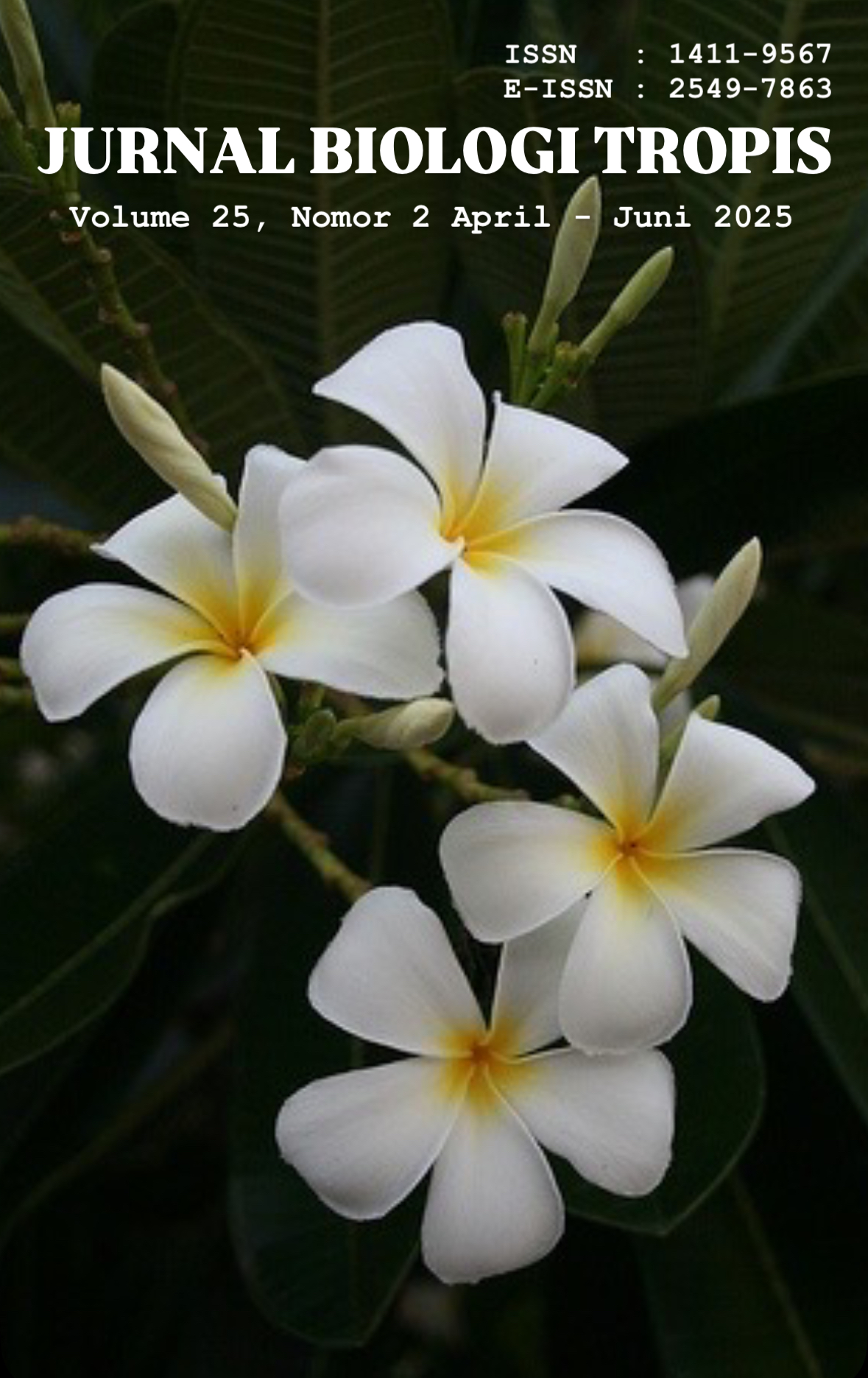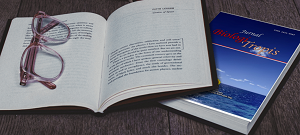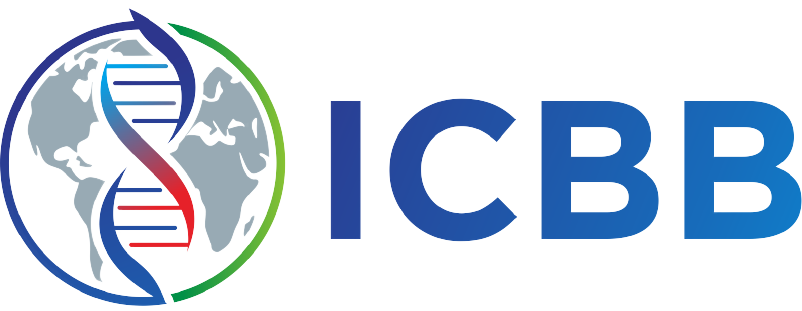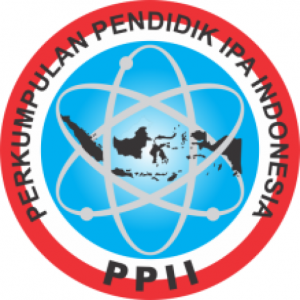Identification of Secondary Metabolite compounds and Testing of Flavonoid Levels in Beluntas Leaves (Pluchea indica L.)
Authors
Forrela Zahwa Salamah , Mieta Widya Ramadhani , Shinta Nuriyah Wahidah , Rizka Dwi Rahmawati , Nour Athiroh Abdoes Sjakoer , Amartya Gesit Savana , Majida Ramadhan , Faisal Faisal , Nafisa NafisaDOI:
10.29303/jbt.v25i2.8473Published:
2025-04-30Issue:
Vol. 25 No. 2 (2025): April-JuniKeywords:
Beluntas leaf, extract, flavonoid, secondary metabolite.Articles
Downloads
How to Cite
Downloads
Metrics
Abstract
Most Indonesian people still use traditional medicine because Indonesian medicinal plants can potentially be the main ingredient in medicine They contain various types of natural chemical compounds with diverse pharmacological and biodiversity effects. Several plants that usually grow around the yard and are easy to grow are beluntas (Pluchea indica (L.)). Beluntas are consumed as an additional ingredient when eating or processed as a herbal concoction. This study identified secondary metabolite compounds and total flavonoid levels in beluntas leaves. Beluntas leaves (Pluchea indica (L.)) were extracted using ethanol solvents and then tested using several reagents to identify their compound content. The total flavonoid test in the beluntas leaf extract was also conducted by adding a 10% aluminum chloride solution, sodium acetate, and aquadest to the extract sample, then incubated and measured for absorption using UV-Vis spectrophotometry in the wavelength range between 415-440 nm. This study demonstrates that beluntas leaves contain bioactive compounds including steroids, alkaloids, flavonoids, and tannins with a total flavonoid content recorded at 71.567±70.446 mg/g.
References
Amelia, R., Riky, & Ngazizah, F.N. (2021). Analisa Ekstrak Etil Asetat Akar Kaik-Kaik (Uncaira cordta (Lour.) Merr.) Terhadap Pertumbuhan Bakteri Staphylococcus aureus. Journal of Indonesian Medical Laboratory and Science, 2(1), 68-82. https://doi.org/10.53699/joimedlabs.v2i1.24.
Azizah, B., & Nina, S. (2014). Standarisasi Parameter Non Spesifik dan Perbandingan Kadar Kurkumin Ekstrak Etanol dan Ekstrak Terpurifikasi Rimpang Kunyit. Yogyakarta: Fakultas Farmasi Universitas Ahmad Dahlan.
Chang, C., Yang, M., Wen, H., dan Chern, J. (2002). Estimaation of Total Flavonoid Content in Propolis by Two Complementary Colorimetric Methods. Journal of Food and Drug Analysis, 10(3), 178-182. https://doi.org/10.38212/2224-6614.2748.
Departemen Kesehatan Republik Indonesia. (2000). Parameter Standar Umum Ekstrak Tumbuhan Obat. Jakarta, Departemen Kesehatan Republik Indonesia.
Gayatri, D.A.A.M., Ernawati, D.K., dan Wdhiartini, I.A.A. (2021). Uji Efektivitas Ekstrak Etanol Daun Beluntas (Pluchea indica L.) Terhadap Pertumbuhan Bakteri Streptococcus Pyogenes ATCC 19615 Secara In Vitro. Jurnal Medika Udayana, 10(1), 7-11. https://doi.org/10.24843/.MU.2021.V10.i1.P02.
Lestari, R. F., S. & Wildaniah, W. (2018). Penetapan Parameter Standar Simplisa dan Ekstrak Etanol Daun Krotom (Mitragyna speciosa Korth) yang Tumbuh di Kabupaten Kapuas dan Kabupaten Melawi. Jurnal Insan Farmasi Indonesia, 1(1), 72 – 84. https://e-jurnal.stikes-isfi.ac.id/index.php/JIFI/article/view/154.
Lestari, K.A.P., Pranoto, P.P., Sofiyah, Musyirah, M., & Pratiwi, F.I. (2020). Antibacterial Activity of Beluntas (Pluchea indica L.) Leaves Extract Using Different Extraction Methods. Jurnal Riset Biologi dan Aplikasinya, 2(2), 49-54. https://doi.org/10.26740/jrba.v2n2.p49-54.
Ergina, Nuryanti, S., & Pursitasari, I.D. (2014). Uji Kualitatif Senyawa Metabolit Sekunder pada Daun Palado (Agave angustifolia) yang Diekstraksi dengan Pelarut Air dan Etanol. Jurnal Akademika Kimia, 3(3), 165-172.
Fahrurroji, A. & Riza, H. (2020). Karakterisasi Ekstrak Etanol Buah Citrus amblycarpa (L), Citrus aurantifolia (S.), dan Citrus sinensis (O.). Jurnal Farmasi dan Ilmu Kefarmasian Indonesia, 7(2), 100-113. https://doi.org/10.20473/jfiki.v7i22020.100-113.
Ilyas, A. (2013). Kimia Organik Bahan Alam. Edited by Maswati Baharuddin. 1st ed. Alauddin University Press.
Krisdiyanto, N.R., dan Sa’ad, M. (2023). Kadar Flavonoid Total Ekstrak Etanol Daun Jarak Pagar (Jatropha curcas L.) dengan Metode Spektrofotometri UV-Visibel. Pharmacy Medical Journal, 6(1), 34-42. https://doi.org/10.35799/pmj.v6i1.48103.
Muthmainnah, B. (2019). Skrining fitokimia senyawa metabolit sekunder dari ekstrak etanol buah delima (Punica granatum L.) dengan metode uji warna, Media Farmasi, 13(2), 36–41. https://doi.org/10.32382/mf.v13i2.880.
Pelu, D. A. (2017). Tanaman Beluntas (Pluchea indica L) Asal Maluku. Global Health Science, 2(4), 390-393. http://dx.doi.org/10.33846/ghs.v2i4.171.
Riyani, N., Rahardjo, D., dan Permatasari, D.A.i. (2022). Kadar Flavonoid dan Antioksidan Ekstrak Etanol dan Fraksi Batang Beluntas (Pluchea indica Less.) Metode ABTS+. Jurnal Kesehatan Warta Bhakti Husada Mulia, 9(2), 1-13.
Roring, N., Yudistira, A. & Lolo, W. A. (2017). Standarisasi Parameter Spesifik Dan Uji Aktivitas Antikanker Terhadap Sel Kanker Payudara T47D Dati Ekstrak Etanol Daun Keji Beling (Strobilantes crispa (L.) Blume). Jurnal Ilmiah Farmasi, 6(3), 176-185. https://doi.org/10.35799/pha.6.2017.16882.
Rusdianto, Susanti, Kusmita, T., Aryanto, L., Talitha, dan Mursid. (2023). Analisis Uji Chemical Oxygen Demand (COD) pada Air Limbah Sawit di DInas Lingkungan Hidup dan Kehutanan Provinsi Bangka Belitung. Jurnal Riset Fisika Indonesia, 3(2), 26-31. https://doi.org/10.33019/jrfi.v3i2.3553
Sahumena, M.H., Ruslin, Asriyanti, dan Djuwarno, E.N. (2020) Identifikasi Jamu yang Beredar di Kota Kendari Menggunakan Metode Spektrofotometri UV-Vis. Journal Syifa Sciences and Clinical Research, 2(2):65-72. https://doi.org/10.37311/jsscr.v2i2.6977.
Safitri, I., Nuria, M. C., & Puspitasari, A. D. (2018). Perbandingan kadar flavonoid dan fenolik total ekstrak metanol daun beluntas (Pluchea indica L.) pada berbagai metode ekstraksi. Jurnal Inovasi Teknik Kimia, 3(1), 31-36. http://dx.doi.org/10.31942/inteka.v3i1.2123.
Sari, D.Y., Widyasari, R., & Taslima, A.N. (2021). Penentuan Kadar Flavonoid Total Ekstrak Etanol Jamur Susu Harimau (Lignosus rhinocerus). Jurnal Farmasi Udayana, 10(1), 23-30. https://doi.org/10.24843/JFU.2021.v10.i01.p03.
Sari, F. Fathul, H, H. Ida, K. Angelia, L, S. (2022). Identifikasi Senyawa Metabolit Ekstrak Etanol Daun Beluntas (Pluche indica) Secara Kualitatif Dengan Kromotografis Lapis Tipis. Junal Sintesis, 3(1), 1-7. https://doi.org/10.56399/jst.v3i1.25
Soerya, M. D. & Suryanti, V.S. (2005). Skrining Fitokimia dan Analisis kromatografi Lapis Tipis Komponen Kimia Buah Labu Siam (Sechium edule Jacq. Swartz.) dalam Ekstrak Etanol Jurnal Biofarmasi, 3(1), 26–31.
Wanita, D., Rusmini, Ashifa, F. & Adriane, F. Y., 2018. Uji Aktivitas Antioksidan Ekstrak Etanol Daun Beluntas (Pluchea indica L.) Dengan Metode DPPH (2,2-Difenil-1-Pikrilhidrazil). Indonesian Chemistry Aplication Journal, 2(2), 25-28. https://doi.org/10.26740/icaj.v2n2.p25-28
WHO. (2008). The Burder Of Diseases 2004 Update Geneva: World Healty Organization.
Yeti, A. & Rafita, Y. (2021). Penetapan Kadar Flavonoid Total Ekstrak Etanol Herba Rumput Bambu (Lopatherum gracile Brogn.) dengan Metode Spektrofotometri Visible. Jurnal Farmasi, Sains, dan Kesehatan, 1(1), 11-19. https://doi.org/10.32696/fjfsk.v1i1.812
Yulianto, Susilo, and Sunarmi Sunarmi. 2018. “Aktivitas Antibakteri Ekstrak Daun Jarak Pagar (Jatropha Curcas L) Terhadap Staphylococcus Epidermidis Dan Staphylococcus Aureus Secara In Vitro.” Interest:Jurnal Ilmu Kesehatan, 7(1), 60–66. https://doi.org/10.37341/interest.v7i1.70.
License
Copyright (c) 2025 Forrela Zahwa Salamah, Mieta Widya Ramadhani, Shinta Nuriyah Wahidah, Rizka Dwi Rahmawati, Nour Athiroh Abdoes Sjakoer, Amartya Gesit Savana, Majida Ramadhan, Faisal Faisal, Nafisa Nafisa

This work is licensed under a Creative Commons Attribution 4.0 International License.

Jurnal Biologi Tropis is licensed under a Creative Commons Attribution 4.0 International License.
The copyright of the received article shall be assigned to the author as the owner of the paper. The intended copyright includes the right to publish the article in various forms (including reprints). The journal maintains the publishing rights to the published articles.
Authors are permitted to disseminate published articles by sharing the link/DOI of the article at the journal. Authors are allowed to use their articles for any legal purposes deemed necessary without written permission from the journal with an acknowledgment of initial publication to this journal.


























